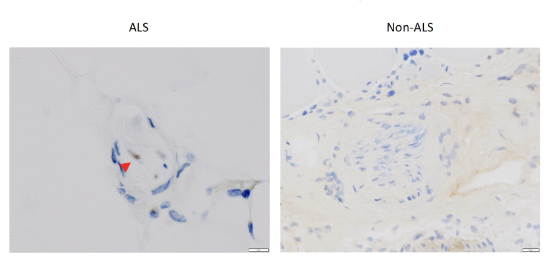E-mail: pr-research*office.hiroshima-u.ac.jp (Please replace * with @)
Amyotrophic lateral sclerosis (ALS) is a progressive disease of the nervous system. It affects nerve cells in the brain and spinal cord called motor neurons. Motor neurons control muscle movement and ALS causes them to deteriorate and eventually die. The motor neurons lose the ability to send messages to the muscles in the body, affecting voluntary muscle movements. There have been recent advances in treating ALS, but current treatments can only slow disease progression. That is why it is important to diagnose ALS as early as possible.
ALS is difficult to diagnose because, currently, there is no single test that can confirm the disease. Doctors look for neurological symptoms such as muscle weakness and upper and lower motor neuron symptoms. They will also do diagnostic tests to rule out other conditions like cervical spondylosis. A diagnostic test that could confirm ALS would help people get a diagnosis earlier and start treatment as soon as possible.
In a paper published on May 23 in JAMA Neurology, researchers outline preliminary research that could pave the way for a future test to diagnose ALS.

Accumulation of TDP-43 with ALS patients
TDP-43 accumulation was evident in intramuscular nerve bundle from ALS patient. (Image courtesy of Takeshi Kurashige, Kure Medical Center)
“It is difficult to diagnose ALS in its early stages because there is not a known biomarker,” said researcher Hirofumi Maruyama, a professor at the Graduate School of Biomedical and Health Sciences at Hiroshima University in Hiroshima, Japan. “Muscle is possible to biopsy, and transactive response DNA-binding protein 43 (TDP-43) accumulates in the peripheral nerves inside muscle. TDP-43 is a protein that plays a key role on motor neurons, and accumulation of TDP-43 may be a biomarker for early diagnosis of ALS.”
Previous research in mice has revealed a crucial function of TDP-43 in axons, the part of the neuron that sends signals to other neurons. This is important for ALS, because axonal degeneration causes the lower motor neuron problems that can be a symptom of ALS. Researchers hypothesized that TDP-43 accumulation in muscular nerve bundles could be an early predictor of ALS.
To test this theory, researchers first examined the muscle tissue of 10 individuals who had confirmed cases of ALS at the time of their death and 12 who did not. All 10 ALS patients had TDP-43 accumulations in their intramuscular nerve bundles, while 12 non-ALS controls had no TDP-43 accumulation.
Next, researchers targeted 114 patients who underwent a muscle biopsy and did not have a family history of ALS or another muscle or neuromuscular diagnosis. Of these, 71 had evidence of intramuscular nerve bundles and 43 did not. Among the 71 patients, axonal TDP-43 accumulations in their nerve bundles were confirmed in 33. These 33 patients with axonal TDP-43 accumulations were all later diagnosed with ALS. Among the 43 patients without nerve bundles, three were later diagnosed with ALS.
“Results of this dual case-control and cohort study suggest that axonal TDP-43 accumulations may be characteristic for patients with ALS, and consequently may be a novel diagnostic biomarker for ALS,” said Maruyama. “Early diagnosis enables patients to initiate prompt treatment. We aim to prevent the progression of ALS and will continue research into developing new medication.”
Other contributors include Takashi Kurashige, Tomomi Murao, Tomohito Sugiura, and Tsuyoshi Torii, Department of Neurology, National Hospital Kure Medical Center and Chugoku Cancer Center; Hiroyuki Morino, Department of Clinical Neuroscience and Therapeutics, Graduate School of Biomedical and Health Sciences, Hiroshima University; Yuishin Izumi, Department of Clinical Neuroscience, Institute of Biomedical Sciences, Tokushima University Graduate School; Kazuya Kuraoka, Department of Diagnostic Pathology, National Hospital Organization Kure Medical Center and Chugoku Cancer Center; and Hideshi Kawakami, Department of Epidemiology, Research Institute for Radiation Biology and Medicine, Hiroshima University.
The Japan Society for the Promotion of Science, the Research Committee of Central Nervous System Degenerative Diseases, Research on Policy Planning and Evaluation for Rare and Intractable Diseases, Health, Labour, and Welfare Sciences Research Grants, the Ministry of Health, Labour, and Welfare of Japan, the Taiju Life Social Welfare Foundation, the Takeda Science Foundation, and the Tsuchiya Memorial Medical Foundation supported this research.
About the study
Journal: JAMA Neurology
Title: TDP-43 accumulation within intramuscular nerve bundles of patients with amyotrophic lateral sclerosis
Authors: Takashi Kurashige, Hiroyuki Morino, Tomomi Murao, Yuishin Izumi, Tomohito Sugiura, Kazuya Kuraoka, Hideshi Kawakami, Tsuyoshi Torii & Hirofumi Maruyama
DOI: 10.1001/jamaneurol.2022.1113
Norifumi Miyokawa
Office of Research and Academia-Government-Community Collaboration, Hiroshima University

 Home
Home



